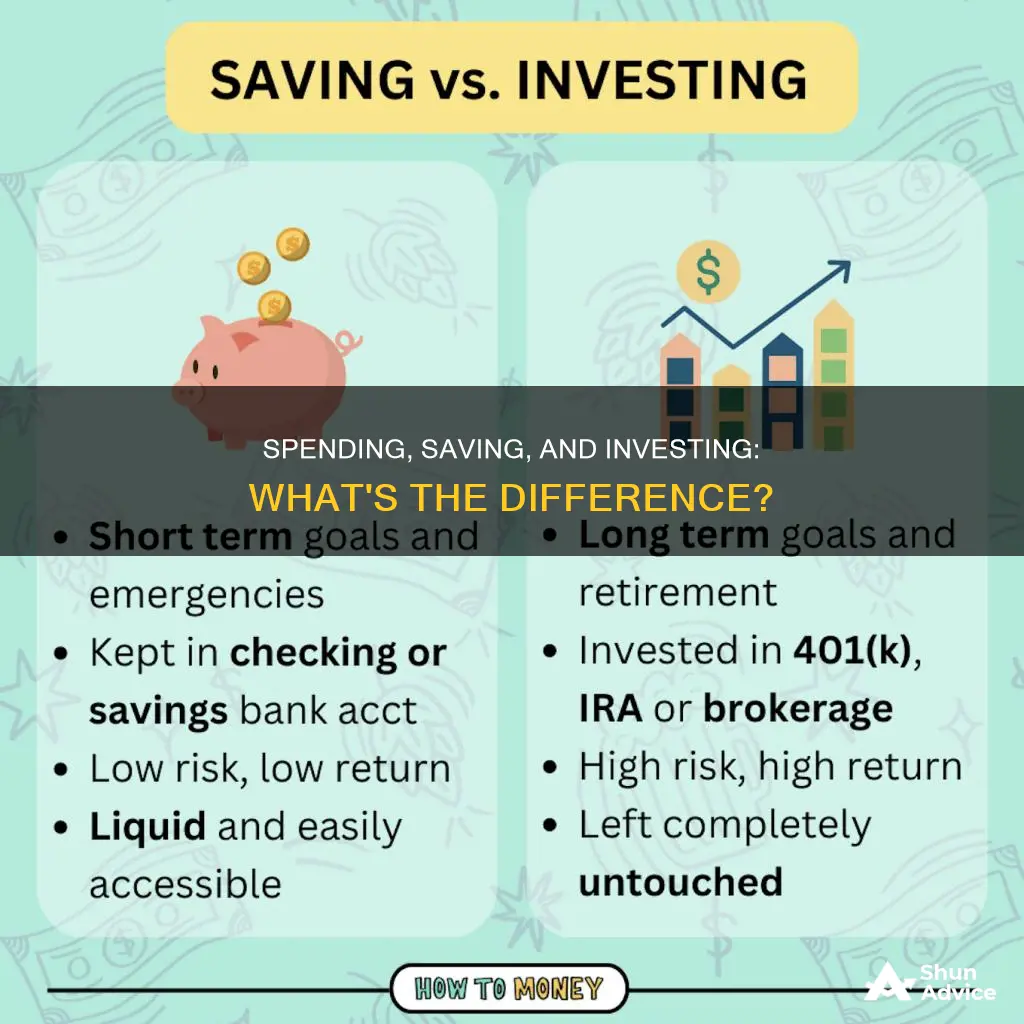
Spending, saving, and investing are three different financial strategies. Spending is when you use your money to buy goods and services. Saving is when you store your money for future use, usually in a savings account with low risk and low returns. Investing, on the other hand, is when you put your money into financial instruments such as stocks, bonds, and mutual funds with the expectation of earning higher returns over the long term. While saving is generally considered safer, investing offers the potential for greater wealth accumulation. Both saving and investing are crucial components of a solid financial plan, and understanding the differences between them can help you make better financial decisions.
What You'll Learn

Saving for emergencies
- Set a goal: Aim to save at least $1,000 as a starter emergency fund. This will provide a cushion for minor financial setbacks.
- Create a budget: Understand your income and expenses by creating a budget. Track your monthly income and expenses, and look for ways to increase your income and reduce unnecessary spending.
- Cut expenses: Identify areas where you can cut back on spending. Consider cancelling subscriptions, cooking at home instead of dining out, or switching to cheaper grocery stores.
- Automate your savings: Set up automatic transfers to your emergency fund from your paycheck or monthly income. This helps you save consistently without having to remember to transfer funds manually.
- Choose the right account: Keep your emergency fund in a separate account from your checking account to avoid the temptation to spend it. Consider high-yield savings accounts or money market accounts that offer higher interest rates than traditional savings accounts. Ensure the account is easily accessible so you can quickly withdraw funds in an emergency.
- Prioritize emergency savings: Treat contributions to your emergency fund as a bill you have to pay. Make it a priority to build up your emergency savings before investing in riskier assets or making extra debt payments.
Investing While Saving for a Home: Wise or Risky?
You may want to see also

Investing for higher returns
Investing is a way to achieve higher returns on your money than simply saving it. When you invest, you buy assets such as stocks, bonds, mutual funds, or real estate, with the expectation that your investment will make money for you over time.
Investing is typically done for the long term, with goals such as saving for a child's college fund or retirement. It is important to note that investing comes with risk; there is always the possibility of losing some or all of your investment capital. However, the potential for higher returns makes it a powerful tool for growing your wealth over time.
One of the key advantages of investing is the potential for higher returns than traditional savings accounts. By investing in stocks, bonds, or other financial instruments, you can benefit from the growth and profits of the companies or industries you invest in. For example, if you buy shares of a company like Apple, and the company performs well, the value of your stock could increase over time, allowing you to sell it for a profit.
Another benefit of investing is the ability to diversify your portfolio. By investing in different companies and industries, you can reduce your risk and potentially achieve even higher returns. Additionally, investing allows you to participate in global financial markets and share in the success of profitable businesses, even if you don't own one yourself.
It's important to remember that investing requires a long-term perspective and discipline. The value of your investments can fluctuate, and there is no guarantee of returns. It's also crucial to do your research and understand the risks associated with different types of investments.
When deciding whether to save or invest, consider your financial goals and time horizon. If you need money in the short term (within the next few years), saving is usually a better option. However, if you're planning for the long term (5 years or more), investing can provide the potential for higher returns and help you achieve your financial goals.
In conclusion, investing is a powerful tool for achieving higher returns and building long-term wealth. By understanding the risks and rewards, doing your research, and maintaining a disciplined approach, you can make informed decisions about when to invest and how to maximize your returns.
Life Cycle Theory: Savings and Investment Strategies Explored
You may want to see also

Saving for short-term goals
- Determine your short-term goals: Examples of short-term financial goals include saving for an emergency fund, a large purchase like a car or appliance, a vacation, or paying off credit card debt. It's important to prioritize your goals based on their importance to you and your financial situation.
- Set clear and achievable targets: When setting your short-term savings goals, make sure they are specific, measurable, achievable, relevant, and time-bound (SMART goals). For example, instead of a general goal of saving money, specify what you're saving for and how much you want to save. This helps you stay focused and motivated.
- Create a budget: Evaluate your expenses and track your spending to understand where your money is going. Creating a budget will help you identify areas where you can cut back and determine how much you can realistically save towards your goals.
- Choose the right savings vehicles: Utilize savings accounts, money market accounts, or certificates of deposit (CDs) for your short-term goals. These options offer liquidity, allowing you to access your funds quickly, and often provide higher interest rates than traditional savings accounts.
- Automate your savings: Set up automatic transfers from your checking account to your savings account. This helps you save consistently without having to remember to transfer funds manually each time.
- Pay down high-interest debt: Focus on paying off debts with the highest interest rates first. This will free up more of your income for savings and help you avoid the burden of accumulating interest.
- Improve your credit score: A good credit score can help you in various financial aspects, such as obtaining loans with favourable terms or qualifying for better credit cards.
- Start saving early: The earlier you start saving for your short-term goals, the easier it will be to achieve them. Even small contributions can add up over time, so don't underestimate the power of starting early.
- Stay disciplined: Saving for short-term goals requires discipline and consistency. Stick to your budget and avoid unnecessary expenses that may derail your progress.
- Consider short-term investments: While investing is typically associated with long-term goals, some short-term investment options can help you grow your money faster. These include money market funds, short-term bonds, and cash management accounts (CMAs). However, remember that investments come with varying levels of risk.
Saving and Investing: Biblical Principles for Financial Wisdom
You may want to see also

Investing for long-term goals
Investing is a way to achieve long-term financial goals. It is important to understand the differences between saving and investing to ensure financial security and a bright future. While both are critical elements of personal finance, investing typically comes with a longer-term horizon and involves taking on some risk.
When investing for long-term goals, it is crucial to consider the time horizon and risk tolerance. Long-term goals are those that are at least ten years or more away, such as retirement funds. With a longer time horizon, investors can generally take on more risk as they have more time to recover from any short-term losses. This is known as having a higher risk tolerance.
Investing for the long term allows individuals to potentially earn higher returns than they would through saving alone. This is because investments such as stocks, bonds, mutual funds, and real estate have the potential to increase in value over time. Compounding returns can also significantly grow retirement savings. Additionally, investing in the stock market can help beat inflation, which can seriously affect the value of cash savings over the long term.
However, it is important to remember that investing comes with no guarantees, and there is always the risk of losing money. Therefore, it is crucial to diversify one's portfolio by investing in different companies and industries to reduce risk.
Before investing for the long term, individuals should ensure they have an emergency fund and have their short-term financial goals covered through savings. This is because savings provide a financial safety net and are generally more liquid and accessible than investments.
By combining saving and investing in a balanced approach, individuals can build wealth, protect against financial shocks, and secure a brighter financial future.
The Investment Savings Curve: A Guide to Financial Strategy
You may want to see also

Saving vs investing: pros and cons
Saving and investing are both important components of a healthy financial plan, but they serve different purposes. Saving is ideal for short-term financial goals and provides a safety net for unexpected situations, while investing is geared towards long-term goals and has the potential for higher returns. Here are the pros and cons of each approach:
Pros and Cons of Saving
Saving is a conservative approach that prioritises liquidity and safety over higher returns. Here are the advantages:
- Financial safety net: Saving provides a cushion for unexpected expenses, such as car repairs or medical bills.
- Liquidity for short-term goals: Savings are easily accessible and can be used for purchases like a new gadget or a vacation.
- Minimal risk of loss: Savings accounts are generally low-risk, and in some cases, they are insured against loss by organisations like the Federal Deposit Insurance Corporation (FDIC).
However, there are also drawbacks to consider:
- Opportunity cost: By keeping funds in a savings account, you may miss out on the potential for higher returns from riskier investments.
- Inflation risk: Savings can lose purchasing power during periods of rising inflation, eroding their value over time.
Pros and Cons of Investing
Investing, on the other hand, involves taking on more risk with the potential for greater rewards. Here are the benefits:
- Potential for higher returns: Investments in stocks, bonds, mutual funds, or real estate have the chance to earn higher returns over the long term compared to savings accounts.
- Wealth accumulation: Investing allows you to grow your wealth over time, helping you achieve long-term financial goals like saving for retirement or buying a house.
- Diversification: By investing in different companies, industries, or types of investments, you can reduce your risk and improve your overall portfolio performance.
However, investing is not without its risks and considerations:
- Risk of loss: There is always the possibility of losing some or all of your investment capital, especially in the short term.
- Volatility: The value of investments can fluctuate due to changes in the economy or a company's performance, introducing uncertainty.
- Long-term horizon: Investing typically requires a longer time horizon, usually at least five years, to ride out short-term downturns and realise potential gains.
In conclusion, both saving and investing play important roles in financial planning. Saving is ideal for short-term goals and building an emergency fund, while investing is better suited for long-term goals and offers the potential for higher returns. The right approach depends on your financial situation, goals, and risk tolerance.
Unlocking the Power of Savings and Investments
You may want to see also
Frequently asked questions
Spending is when you exchange your money for goods and services. Saving is when you store your money to use in the near future, usually in a savings account. Investing is when you put your money into financial instruments, such as stocks or property, to earn a return over time.
Saving is a good strategy if you need your money in a short time. Your savings are easily accessible and insured against loss.
Savings accounts offer low returns, which may not keep up with the cost of living, causing you to lose some of your money's buying power over time.
Investing is a good strategy for achieving long-term financial goals. It offers the potential for higher returns than savings accounts and can help you grow your wealth over time.
Investing comes with the risk of losing money. It requires a long-term commitment and can be complex and volatile.







